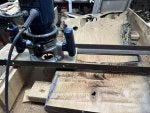Getting ready to flatten a slab. Its close. It was flattened a year ago and cupped a bit.
I am making a router sled to do this with a 2” planing bit
I have the slab on the bench. I put a piece of ply, 6” tall, on each side and secured them, level and straight with each other.
the slab goes in the middle. I will screw a 2x4 under each side from the bottom, shim it level and fasten it to the bench.
At that point, all is straight and secure.
For the sled to ride on top of the ply, 3/4 stock seems solid. But this is about 1/2 above the slab. Plus the router will be mounted on the sled. So, the router shaft is not very deep into the router. Its a 1/4 shaft.
questions are
1) will this be ok or does that create too much room for movement
2) does it matter if i use my full size router (still 1/4 and an inexpensive Ryobi) or a smaller trimmer (also inexpensive from Harbor Freight)
![Image]()
![Image]()
![Image]()
I am making a router sled to do this with a 2” planing bit
I have the slab on the bench. I put a piece of ply, 6” tall, on each side and secured them, level and straight with each other.
the slab goes in the middle. I will screw a 2x4 under each side from the bottom, shim it level and fasten it to the bench.
At that point, all is straight and secure.
For the sled to ride on top of the ply, 3/4 stock seems solid. But this is about 1/2 above the slab. Plus the router will be mounted on the sled. So, the router shaft is not very deep into the router. Its a 1/4 shaft.
questions are
1) will this be ok or does that create too much room for movement
2) does it matter if i use my full size router (still 1/4 and an inexpensive Ryobi) or a smaller trimmer (also inexpensive from Harbor Freight)








